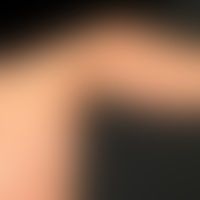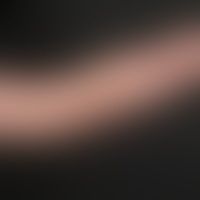Asymmetrical nevus flammeus Images
Go to article Asymmetrical nevus flammeus
Naevus flammeus (port wine stain): congenital erythema in the facial region (capillary vascular malformation), localized in V2 distribution, completely without symptoms. 4-month-old boy, developed according to age.

Naevus flammeus (Port-wine stain): congenitalerythema in the facial region (capillary vascular malformation), localized in V2 distribution, completely without symptoms. 4-month-old boy, developed according to age.

Nevus flammeus (port wine stain): congenital erythema in the facial region (capillary vascular malformation), localized in V2 distribution, completely without symptoms; control image after 4 years

Naevus flammeus (Port-wine stain): sharply defined red vascular nevus that affects the upper and lower eyelid as well as the temporal region.

Naevus flammeus (Port-wine stain): fuzzy-limited red vascular nevus on the forehead (spreading area of N.V1 and NV2) and cheeks.

Naevus flammeus lateralis: Sharply limited, asymptomatic, livid-blueish spot with a gradually deepening colour tone over the years.

Vascular (capillary) malformation (so-called naevus flammeus): Congenital, generalized, spotty erythema from the scalp to the sole of the foot in an 8-year-old boy, developed according to age.


Naevus flammeus lateralis: Sharply limited livid-blueish spot with increasing deepening of the colour in the area of the lateral upper lip and philtrum.

Vascular (capillary) malformation (naevus flammeus): Congenital, generalized, symptomless, spotty erythema on the face and trunk in a 9-year-old boy, developed according to age.

Naevus flammeus: congenital, completely symptomless vascular malformation (exclusively capillary malformation) without tendency to tissue hypertrophy.

Naevus flammeus lateralis. congenital, generalized, spotty erythema on the left arm in an 18-month-old boy with age-appropriate development.

Vascular (capillary) malformation (so-called naevus flammeus): Congenital, generalized, irregularly configured, spotty erythema from the scalp to the sole of the foot in a 5-year-old boy, developed according to age.

Nevus flammeus: harmless, congenital, asymmetric, and asymptomatic, non-syndromic (no tissue hypertrophy, no orthopedic malpositioning), telangiectatic vascular nevus .

Nevus flammeus: harmless, congenital, asymmetric, and asymptomatic, non-syndromic (no tissue hypertrophy, no orthopedic malpositioning), telangiectatic vascular nevus .

Naevus flammeus lateralis Chronic stationary, congenital, bizarre, blurred, symptomless, smooth, red spots (red-blue color in cold environment) localized on the left arm.

Vascular (capillary) malformation (so-called naevus flammeus): Congenital, generalized, irregularly configured, spotty erythema from the scalp to the sole of the foot in an 8-year-old boy, developed according to age.

Nevus flammeus: congenital, asymmetrically positioned, non-syndromal (no tissue hypertrophy, no orthopedic malposition) large-area (telangiectatic) vascular nevus .

Nevus flammeus: congenital, asymmetrically arranged, non-syndromal (no tissue hypertrophy, no orthopedic malposition) large-area (telangiectatic) vascular nevus; characteristic are the scattered borders of the red spots.

Nevus flammeus: congenital, asymmetrically positioned, syndromal (orthopaedic malposition) large-area (telangiectatic) vascular nevus with atrophy of the soft tissues (fatty tissue and muscles)

Nevus flammeus: congenital, asymmetrically arranged, syndromal (orthopedic malposition) large-area (telangiectatic) vascular nevus with atrophy of the soft tissues; characteristic are the scattered edges of the red spots.

Nevus flammeus (detailed picture): congenital, asymmetrically arranged, syndromal (orthopaedic malposition) large-area (telangiectatic) vascular nevus with atrophy of the soft tissues.

Vascular (capillary) malformation (so-called naevus flammeus): Congenital, generalized, irregularly configured, spotty erythema from the scalp to the sole of the foot in an 8-year-old boy, developed according to age.

Naevus flammeus: congenital, bilateral, chronically inpatient, bizarre, asymptomatic, non-syndromal naevus flammeus with livedo-like aspect

Naevus flammeus: congenital, unilateral, chronically inpatient, bizarre, sharply defined, symptomless naevus flammeus; increasing thickness of vascular lesions with a tendency to focal bleeding after banal trauma.

Vascular (capillary) malformation (so-called naevus flammeus): Congenital, generalized, irregularly configured, spotty erythema from the scalp to the sole of the foot in a 5-year-old boy, developed according to age. Here changes of the sole of the foot.

Lateral flammeus nevus, beginning angiomatous transformation (red-blue soft papules).

Vascular twin nevus: Combination of a nevus flammeus with a nevus anaemicus.

Vascular twin nevus: Combination of a nevus flammeus with a nevus anaemicus.

Vascular twin nevus: Combination of a flammeus nevus with an anaemic nevus. encircles a large overlap zone. arrows mark the scattered areas of the anaemic nevus.





